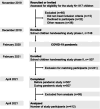Changes in handwashing knowledge, attitudes, and practices among primary schoolchildren in Ulaanbaatar, Mongolia during the COVID-19 pandemic
- PMID: 40575101
- PMCID: PMC12198215
- DOI: 10.3389/fpubh.2025.1570178
Changes in handwashing knowledge, attitudes, and practices among primary schoolchildren in Ulaanbaatar, Mongolia during the COVID-19 pandemic
Abstract
Introduction: The coronavirus disease 2019 (COVID-19) pandemic has highlighted the critical importance of handwashing as a preventive measure against the spread of SARS- CoV-2. This study aimed to assess changes in handwashing knowledge, attitudes, and practices (KAP) among primary schoolchildren in Ulaanbaatar, Mongolia, before and during the pandemic.
Methods: A longitudinal study was conducted with 399 children aged 8-11 years, with data collected in December 2019 (pre-pandemic) and January 2021 (during the pandemic). A self-reported questionnaire was used to assess the children's handwashing KAP, focusing on four critical moments for handwashing: after using the toilet, before eating, after touching visibly dirty or unhygienic things, and after coming home.
Results: The results showed a significant increase in handwashing knowledge and attitudes during the pandemic, with the average knowledge score rising from 9.8 to 12.3 and the percentage of correct responses about critical handwashing moments increasing from 23.0 to 80.4%. Handwashing practices also improved, with an increased frequency of handwashing at critical moments, although practice before eating remained unchanged. Sociodemographic factors, such as sex, grade level, and parental education, were associated with handwashing behaviors. Girls were significantly more likely to engage in proper handwashing (AOR = 4.50, p < 0.01), while fourth-grade students showed higher odds of practicing proper handwashing than third-grade students (AOR = 5.27, p < 0.01). Fathers' higher education and maternal self-employment were positively associated with proper handwashing, whereas fathers' employment in public service was negatively associated. The overall KAP scores showed a significant increase during the pandemic, with a mean difference of 3.68 [95% CI = (4.06, 3.29), p < 0.01], indicating a notable improvement in handwashing behavior.
Discussion: These findings highlight the importance of health education and interventions in shaping children's hygiene behaviors during global health crises, with lasting implications for public health strategies, particularly in resource-limited settings.
Keywords: COVID-19; Mongolia; handwashing; knowledge, attitude, and practice (KAP); schoolchildern.
Copyright © 2025 Enkhbat, Togoobaatar, Erdenee and Takekuma.
Conflict of interest statement
The authors declare that the research was conducted in the absence of any commercial or financial relationships that could be construed as a potential conflict of interest.
Figures


Similar articles
-
Measures implemented in the school setting to contain the COVID-19 pandemic.Cochrane Database Syst Rev. 2022 Jan 17;1(1):CD015029. doi: 10.1002/14651858.CD015029. Cochrane Database Syst Rev. 2022. Update in: Cochrane Database Syst Rev. 2024 May 2;5:CD015029. doi: 10.1002/14651858.CD015029.pub2. PMID: 35037252 Free PMC article. Updated.
-
Hand Hygiene Knowledge, Attitudes, Practices, and Hand Dirtiness of Primary School Students Before and After a Behavioral Change Intervention During the COVID-19 Pandemic, Belize 2022-2023.Am J Trop Med Hyg. 2025 May 27;113(2):427-436. doi: 10.4269/ajtmh.24-0617. Print 2025 Aug 6. Am J Trop Med Hyg. 2025. PMID: 40425004
-
Knowledge, attitudes, and practices of hygiene among children in schools of Central Kazakhstan: a cross-sectional study.Front Public Health. 2025 Jun 3;13:1595672. doi: 10.3389/fpubh.2025.1595672. eCollection 2025. Front Public Health. 2025. PMID: 40529691 Free PMC article.
-
Effect of virtual education on health responsibility of overweight students during the COVID-19 pandemic.BMC Public Health. 2024 Nov 13;24(1):3145. doi: 10.1186/s12889-024-20593-8. BMC Public Health. 2024. PMID: 39538224 Free PMC article. Clinical Trial.
-
The educational effects of portfolios on undergraduate student learning: a Best Evidence Medical Education (BEME) systematic review. BEME Guide No. 11.Med Teach. 2009 Apr;31(4):282-98. doi: 10.1080/01421590902889897. Med Teach. 2009. PMID: 19404891
References
-
- Centers for Disease Control and Prevention . Centers for disease control and prevention. COVID-19. Available online at: https://www.cdc.gov/coronavirus/2019-ncov/index.html (Accessed January 01, 2023).
-
- WHO . (2020). WHO issues its first emergency use validation for a COVID-19 vaccine. Available online at: https://www.who.int/news/item/31-12-2020-who-issues-its-first-emergency-... (Accessed January 29, 2025).
MeSH terms
LinkOut - more resources
Full Text Sources
Medical
Miscellaneous

